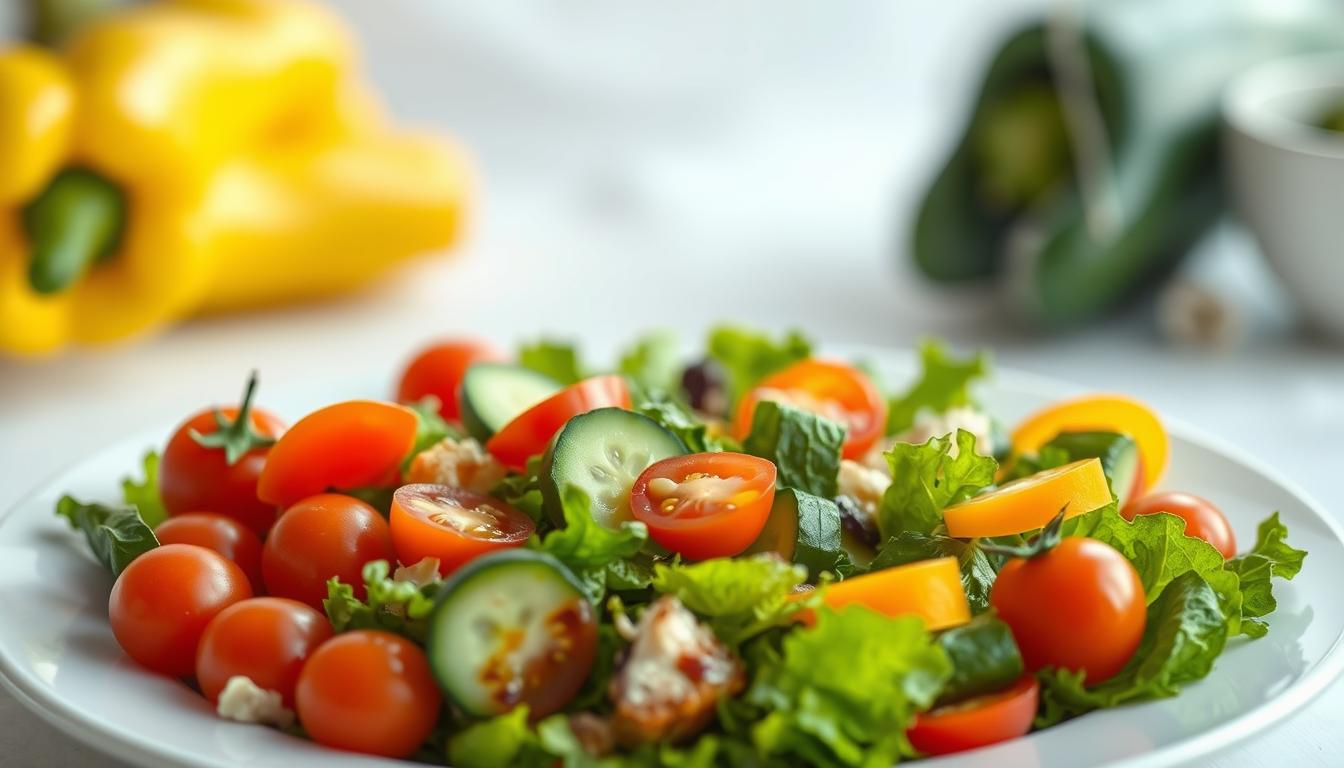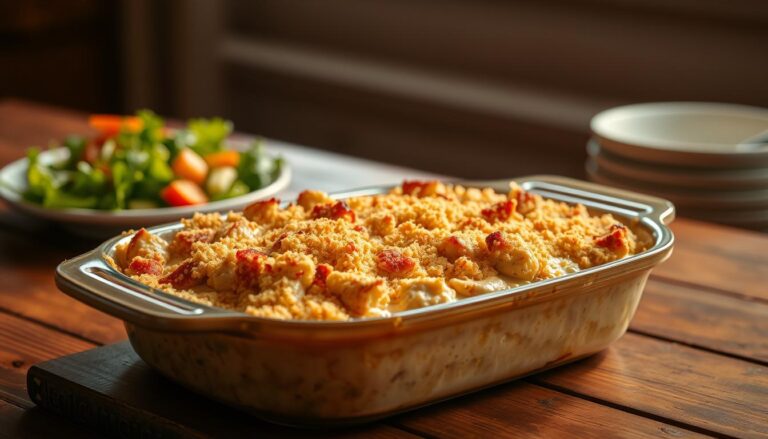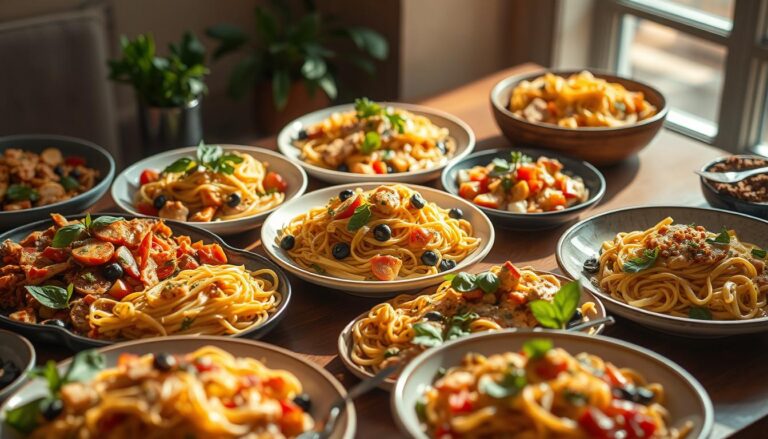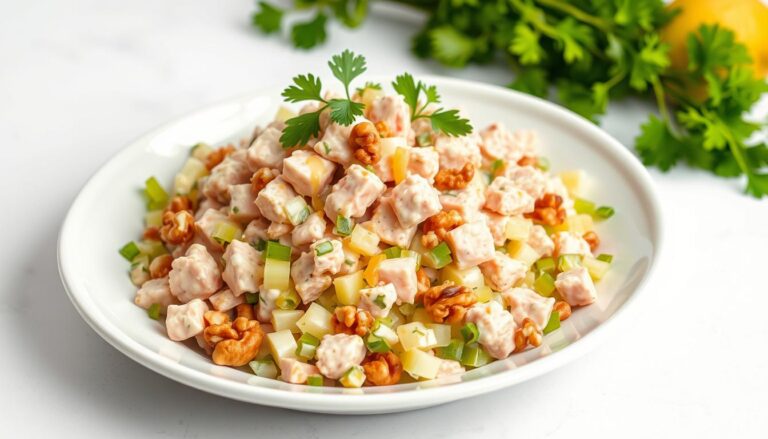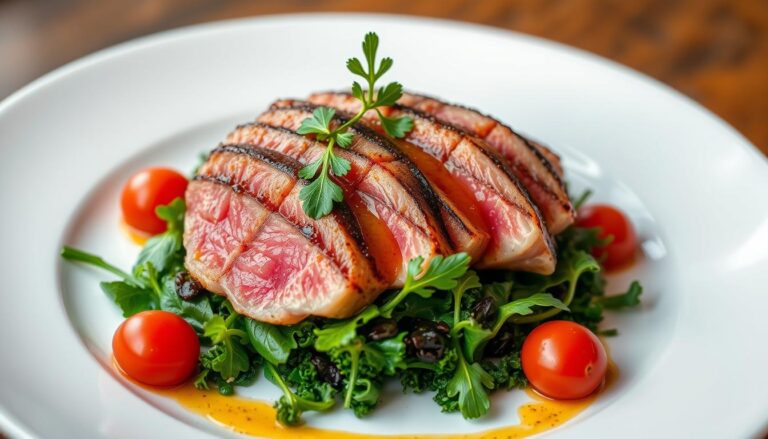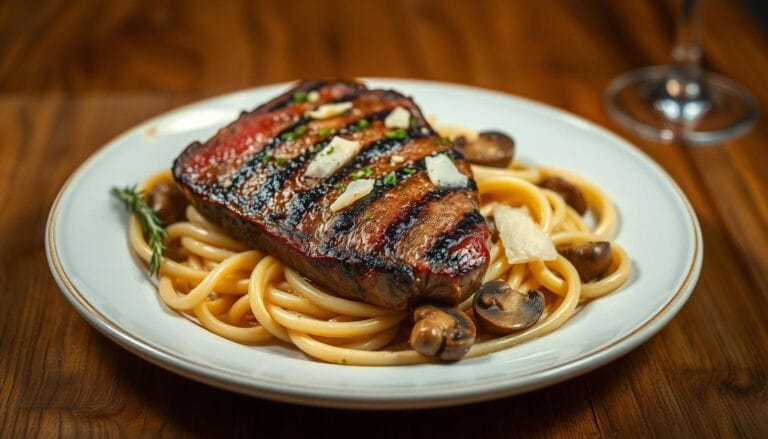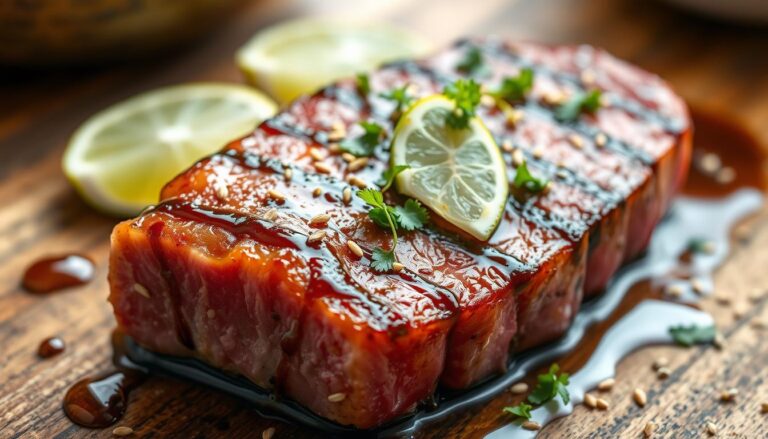Satisfying Low Calorie Salad Recipes to Try
Ever had trouble finding a meal that’s tasty and healthy? Low calorie salad recipes are your answer. They turn healthy eating into a fun food adventure. Enjoy vibrant, tasty dishes that are good for you without losing flavor.
Healthy eating today is about smart, creative cooking. Low calorie salad recipes are a great way to eat well without too many calories. They help you manage your weight or just live healthier.
Finding the right healthy salad dressing can make a salad amazing. You’ll learn to make delicious, light salads. They show that healthy food can be a real treat.
Table of Contents
Understanding the Benefits of Light and Nutritious Salads
Salads are more than just a side dish. They’re a powerful way to nourish your body with essential nutrients. The right nutrient-dense salad mix can transform your eating habits and support your overall wellness goals.
Exploring the world of light salad ingredients reveals a treasure trove of health advantages. These low-calorie meals pack a serious nutritional punch. They offer a smart approach to eating that doesn’t compromise on flavor or satisfaction.
Health Benefits of Low-Calorie Salads
Low-calorie salads provide numerous health advantages that can dramatically improve your well-being:
- Boost immune system function
- Increase daily vegetable intake
- Promote better digestion
- Support heart health
Nutritional Value and Weight Management
Your weight management journey can significantly benefit from strategic salad consumption. Nutrient-dense salad mixes help you feel full while keeping calorie intake low.
| Nutrient | Benefits | Typical Amount per Serving |
|---|---|---|
| Fiber | Improves digestion and satiety | 3-5 grams |
| Protein | Supports muscle maintenance | 5-10 grams |
| Vitamins | Enhances immune function | 20-30% daily value |
Role in Balanced Diet
Integrating light salad ingredients into your daily meals creates a balanced approach to nutrition. These colorful, nutrient-packed dishes help you maintain optimal health. You can enjoy delicious, satisfying meals while doing so.
Essential Ingredients for Creating Satisfying Low Calorie Salads
Making tasty low-calorie salads begins with picking the right ingredients. Choose options that are good for you and full of flavor. This way, your salad can be both healthy and satisfying.
The base of a great salad is fresh, crisp veggies. They add volume, important nutrients, and few calories. Here are some top picks:
- Leafy greens (spinach, arugula, kale)
- Crisp cucumber slices
- Colorful bell peppers
- Radishes
- Cherry tomatoes
Adding protein is key, but choose lean options. This keeps your salad filling without too many calories. Low-fat toppings can make a simple salad into a hearty meal.
| Protein Source | Calories per 3 oz | Protein Content |
|---|---|---|
| Grilled chicken breast | 140 | 26g |
| Canned tuna | 100 | 22g |
| Hard-boiled egg | 70 | 6g |
| Tofu | 60 | 8g |
Choosing the right dressing is crucial to keep calories low. Go for vinegar-based dressings or make your own with herbs and a bit of olive oil. Aim for lots of flavor with minimal calories.
By picking the right ingredients and knowing portion sizes, you can make salads that are both tasty and healthy. This way, you meet your nutritional goals while enjoying your food.
Fresh and Vibrant Protein-Rich Salad Options
Making a tasty and healthy salad means choosing the right protein. Adding high-protein ingredients can turn a simple meal into a filling and healthy choice. It keeps you full and gives you energy all day long.
The protein you pick greatly affects your meal’s nutrition and taste. Your salads should have lean, nutrient-rich proteins that help you reach your health goals.
Lean Protein Choices for Salads
- Grilled chicken breast (3 oz, 26g protein)
- Baked salmon (3 oz, 22g protein)
- Shrimp (3 oz, 20g protein)
- Hard-boiled eggs (1 egg, 6g protein)
Plant-Based Protein Alternatives
- Tofu (1/2 cup, 10g protein)
- Chickpeas (1/2 cup, 7g protein)
- Quinoa (1/2 cup, 4g protein)
- Edamame (1/2 cup, 8g protein)
Portion Control Guidelines
For your salad, aim for 3-4 ounces of lean protein. This helps you get enough protein without too many calories. Measuring your portions helps you stick to your weight loss goals.
Protein keeps your muscles strong and helps you feel full. This makes your salads not only good for you but also very satisfying.
Low Calorie Salad Recipes Under 100 Calories

Discovering tasty low calorie salad recipes can change your meal planning. Fresh vegetable salads are great for those who want healthy meals without too many calories. These dishes show that you can eat well without losing flavor.
Check out these amazing low calorie salad recipes that keep you full and meet your nutritional needs:
- Cucumber Tomato Crunch Salad (80 calories)
- Spinach Micro Green Salad (65 calories)
- Zesty Pepper Medley (90 calories)
These recipes pack a punch with flavor thanks to smart ingredient choices. The secret is picking fresh veggies and using light, creative dressings. This way, you get the most out of each bite.
| Salad Recipe | Calories | Key Ingredients |
|---|---|---|
| Cucumber Tomato Crunch | 80 | Cucumber, Cherry Tomatoes, Red Onion |
| Spinach Micro Green | 65 | Baby Spinach, Micro Greens, Radish |
| Zesty Pepper Medley | 90 | Bell Peppers, Arugula, Lemon Vinaigrette |
Creating delicious and healthy salads is easy. Remember, portion control and choosing the right ingredients are key to making tasty fresh vegetable salads.
Creative Ways to Add Flavor Without Extra Calories
Turning a plain salad into a tasty treat doesn’t have to hurt your health goals. By choosing the right ingredients, you can make your salad taste amazing without adding extra calories.
Making your own healthy salad dressings is simpler than you might think. These homemade options can greatly enhance your salad’s flavor without adding extra calories.
Homemade Dressing Options
- Citrus vinaigrette with lemon and herbs
- Balsamic reduction with fresh garlic
- Greek yogurt-based dressings
- Apple cider vinegar and mustard blend
Herb and Spice Combinations
Fresh herbs and spices are your secret weapons for adding exciting flavors to your salads. They bring a lot of taste without adding many calories.
- Basil and mint for a refreshing kick
- Cilantro and cumin for southwestern flair
- Rosemary and thyme for earthy notes
- Paprika and cayenne for subtle heat
Calorie-Smart Toppings
Choosing the right toppings can turn your salad into a masterpiece. Pick ingredients that add texture and flavor without adding too many calories.
- Nutritional yeast for cheesy flavor
- Pickled vegetables for tanginess
- Toasted seeds for crunch
- Microgreens for visual appeal
Remember, great flavor doesn’t require high calories – it requires creativity and smart ingredient selection!
Seasonal Ingredients for Year-Round Salad Making

Making tasty fresh vegetable salads all year needs knowing when to pick the best produce. Your salad mix can change with the seasons, bringing new tastes and health benefits.
Summer is full of fresh, crunchy veggies for light, cool salads. You’ll find juicy tomatoes, crisp cucumbers, and sweet bell peppers at their best. Winter, on the other hand, offers strong greens and roasted roots for hearty, warm salads.
- Spring: Asparagus, radishes, spring onions
- Summer: Tomatoes, zucchini, corn
- Fall: Butternut squash, Brussels sprouts, apples
- Winter: Kale, roasted beets, citrus fruits
Choosing ingredients from local farmers markets is a great idea. They offer the freshest, most nutritious produce. Your salads will be delicious and help local farmers.
| Season | Top Salad Ingredients | Nutritional Highlights |
|---|---|---|
| Spring | Spinach, Peas | High in Vitamin K, Folate |
| Summer | Tomatoes, Cucumbers | Rich in Hydration, Antioxidants |
| Fall | Kale, Squash | Excellent Fiber, Vitamin A |
| Winter | Cabbage, Carrots | Immune-Boosting Nutrients |
Switching up your ingredients with the seasons keeps your salads fresh and full of nutrients. Try new mixes to find your favorite salads all year.
Quick and Easy Low Calorie Salad Preparations
Turning calorie-conscious salads into satisfying meals is easy. You can make healthy salads fast, even on busy days. Just use smart strategies and quick techniques.
Making tasty, healthy salads is all about planning and smart shortcuts. The goal is to make salad prep easy and fun.
Time-Saving Preparation Techniques
- Wash and chop veggies ahead of time
- Choose pre-washed greens
- Get good food storage containers
- Make proteins in big batches
Smart Meal Prep Strategies
Make your salads easy with smart prep. Here’s how:
- Spend 1-2 hours a week on prep
- Make mason jar salads for on-the-go
- Batch cook proteins like chicken or tofu
- Put ingredients in grab-and-go containers
Optimal Storage Solutions
Right storage keeps your salad ingredients fresh. Use airtight containers and keep wet and dry ingredients separate to keep things crisp.
“Preparation is the secret ingredient to consistently enjoying healthy, delicious salads.” – Nutrition Expert
With these tips, you’ll make quick, tasty salads that fit your busy life.
Building a Balanced Low Calorie Salad Bowl
Making a healthy salad bowl is all about planning. You want to mix light ingredients with protein to keep it nutritious and light.
Begin with a base of leafy greens. Spinach, kale, and arugula are great choices. They’re full of vitamins and minerals but low in calories.
- Choose dark, vibrant greens for maximum nutritional impact
- Aim for at least 2-3 cups of mixed greens per serving
- Rotate different greens to prevent taste fatigue
Protein is key to a filling salad. Add lean proteins like grilled chicken, tofu, or chickpeas. This turns your salad into a full meal.
| Protein Source | Calories per 100g | Protein Content |
|---|---|---|
| Grilled Chicken Breast | 165 | 31g |
| Baked Tofu | 144 | 17g |
| Chickpeas | 164 | 9g |
Pro tip: Add a small amount of complex carbs and healthy fats for a truly satisfying meal.
“A well-constructed salad can be a complete meal, not just a side dish.” – Nutrition Expert
Don’t be afraid to try new combinations. Your ideal salad bowl is a journey of taste and health.
Smart Swaps for Traditional High-Calorie Ingredients
Turning your salad into a weight-loss meal doesn’t mean losing flavor. By swapping ingredients, you can cut calories and keep your salad tasty and healthy.
Let’s look at some smart low-fat salad toppings to replace high-calorie ingredients:
- Replace croutons with roasted chickpeas for crunch and protein
- Swap mayonnaise-based dressings with Greek yogurt alternatives
- Use seeds instead of nuts for texture with fewer calories
- Choose fresh herbs over cheese for flavor enhancement
Weight-loss salads aim to be nutritious and low in calories. Here are some smart ingredient swaps:
| High-Calorie Ingredient | Low-Fat Alternative | Calorie Reduction |
|---|---|---|
| Bacon bits | Sunflower seeds | 50-75 calories per serving |
| Creamy dressings | Vinegar-based vinaigrettes | 100-150 calories per serving |
| Croutons | Roasted chickpeas | 30-50 calories per serving |
With these simple swaps, you can make delicious salads that help with your health and weight goals. You won’t miss out on flavor or texture.
Tips for Making Your Salads More Filling
Making salads that are both tasty and filling is possible. It’s all about choosing the right ingredients and preparing them well. This way, you get more nutrition and feel full longer.
Adding Volume with Low-Calorie Options
Make your salads bigger without adding calories. Use these ingredients to add bulk:
- Leafy greens like spinach and arugula
- Cucumber slices
- Raw zucchini ribbons
- Cauliflower rice
- Sliced radishes
Texture Combinations for Satisfying Salads
Texture is key to a satisfying salad. Mix different textures to keep your taste buds happy and your hunger at bay:
| Texture Type | Ingredient Examples |
|---|---|
| Crunchy | Toasted seeds, nuts, raw vegetables |
| Creamy | Avocado, Greek yogurt, hummus |
| Chewy | Quinoa, roasted chickpeas |
Satiety-Boosting Elements
To make your salads more filling, add protein and healthy fats:
- Grilled chicken breast
- Baked tofu
- Hard-boiled eggs
- Edamame
- Small portions of nuts or seeds
The aim is to create a salad that’s full of nutrients. It should keep you full and give you energy without too many calories.
Conclusion
Your journey through low calorie salad recipes doesn’t have to be dull. These weight-loss salad ideas are a tasty way to improve your nutrition. You’ve seen how fresh ingredients, proteins, and unique flavors can make healthy eating fun.
This guide shows how easy it is to make healthy meals that help you reach your health goals. Low calorie salads are more than just food for diets. They’re a way to enjoy flavors, textures, and take care of yourself. You can make these changes a part of your daily life, making every meal a chance to nourish and please yourself.
Creating the perfect salad is all about what you like. Try new ingredients, different proteins, and be creative with your salads. Your health journey is unique, and these recipes help you reach your goals while enjoying your food.
By following these tips, you’re not just changing your diet. You’re starting a lifestyle that values nutrition, taste, and your well-being. Start exploring, keep learning, and enjoy the tasty world of low-calorie salads that awaits you.
FAQ
How many calories are typically in a low-calorie salad?
A low-calorie salad usually has 100-300 calories. This is because they are made with fresh veggies, lean proteins, and light dressings. These ingredients help you stay healthy and manage your weight.
What are the best protein sources for low-calorie salads?
Good protein choices for salads include grilled chicken, hard-boiled eggs, tofu, edamame, tuna, and chickpeas. These add nutrition without many calories. They help you feel full and happy.
How can I make my salad more filling without adding too many calories?
To make your salad more filling, add high-fiber veggies like spinach and kale. Include lean proteins and a bit of healthy fats like avocado. These ingredients add volume and nutrition without too many calories.
Are homemade salad dressings better for low-calorie diets?
Yes, homemade dressings are better. You can control the ingredients and calories. Use vinegar, Greek yogurt, lemon juice, herbs, and a little oil to make tasty, low-calorie dressings.
Can I prepare salads in advance for the week?
Yes, preparing salads ahead is a great idea. Store greens and wet ingredients separately. Keep dressings on the side. Use airtight containers and prep ingredients like chopped veggies and proteins for quick meals.
What are some low-calorie salad ingredients that add flavor?
Add flavor with ingredients like fresh herbs, citrus zest, pickled veggies, and roasted garlic. Also, try fresh berries and spices. These add taste without extra calories.
How do seasonal ingredients impact low-calorie salads?
Seasonal ingredients bring peak flavor and nutrition. They are often cheaper too. Using fresh, seasonal produce makes your salads diverse and balanced all year.
What are some plant-based protein alternatives for salads?
Great plant-based proteins for salads include quinoa, lentils, black beans, and chickpeas. Also, try tofu, tempeh, seitan, and nut-based proteins like almonds. These add protein and nutrition to your salads.
How can I make sure my salad is nutritionally balanced?
For a balanced salad, mix leafy greens, lean proteins, complex carbs, and healthy fats. Choose colorful veggies, a protein source, and a light dressing. This ensures your salad is nutritious.
Are there any tricks to making salads more satisfying?
To make salads more satisfying, mix textures and include protein and fiber. Use herbs and spices for flavor. Also, control your portions. Choosing the right ingredients makes your salads both healthy and tasty.

